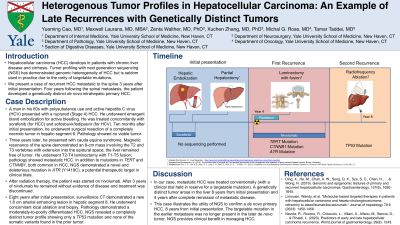Tuesday Poster Session
Category: Liver
P4843 - Heterogeneous Tumor Profiles in Hepatocellular Carcinoma: An Example of Late Recurrences With Genetically Distinct Tumors
Tuesday, October 29, 2024
10:30 AM - 4:00 PM ET
Location: Exhibit Hall E

Has Audio

Yueming Cao, MD
Yale New Haven Health
New Haven, CT
Presenting Author(s)
Yueming Cao, MD, Maxwell Laurans, MD, MBA, Zenta Walther, MD, PhD, Xuchen Zhang, MD, PhD, Michal Rose, MD, Tamar Taddei, MD
Yale New Haven Health, New Haven, CT
Introduction: Hepatocellular carcinoma (HCC) develops in patients with chronic liver disease and cirrhosis. Tumor profiling with next generation sequencing (NGS) has demonstrated genomic heterogeneity of HCC but is seldom used in practice due to the rarity of targetable mutations.
We present a case of recurrent HCC metastatic to the spine 3 years after initial presentation. Four years following the spinal metastasis, the patient developed a genetically distinct de novo intrahepatic primary HCC.
Case Description/Methods: A man in his 60s with polysubstance use and active hepatitis C virus (HCV) presented with a ruptured (Stage 4) HCC. He underwent emergent bland embolization for active bleeding. He was treated concomitantly with sorafenib (for HCC) and sofosbuvir/ledipasvir (for HCV). Ten months after initial presentation, he underwent surgical resection of a completely necrotic tumor in hepatic segment 6.
Three years later, he presented with cauda equina syndrome. Magnetic resonance of the spine demonstrated an 8-cm mass involving the T2 and T3 vertebrae with extension into the epidural space; the liver remained free of tumor. He underwent T2-T4 laminectomy with T1-T5 fusion; pathology showed metastatic HCC. In addition to mutations in TERT and CTNNB1, both common in HCC, NGS demonstrated a novel and deleterious mutation in ATR (Y1419C), a potential therapeutic target in clinical trials.
After radiation therapy, the patient was started on nivolumab. After 3 years of nivolumab he remained without evidence of disease and treatment was discontinued.
Eight years after initial presentation, surveillance CT demonstrated a new 1.8 cm arterial enhancing lesion in hepatic segment 8. He underwent concomitant local ablation and biopsy. Pathology demonstrated a moderately-to-poorly differentiated HCC. NGS revealed a completely distinct tumor profile showing only a TP53 mutation and none of the somatic variants found in the prior tumor.
Discussion: In our case, metastatic HCC was treated conventionally (with a clinical trial held in reserve for a targetable mutation). A genetically distinct tumor arose in the liver 8 years from initial presentation and 4 years after complete remission of metastatic disease.
This case illustrates the utility of NGS to confirm a de novo primary HCC, 8 years from initial presentation. The targetable mutation in the earlier metastasis was no longer present in the later de novo tumor. NGS provides clinical benefit in managing HCC.
Disclosures:
Yueming Cao, MD, Maxwell Laurans, MD, MBA, Zenta Walther, MD, PhD, Xuchen Zhang, MD, PhD, Michal Rose, MD, Tamar Taddei, MD. P4843 - Heterogeneous Tumor Profiles in Hepatocellular Carcinoma: An Example of Late Recurrences With Genetically Distinct Tumors, ACG 2024 Annual Scientific Meeting Abstracts. Philadelphia, PA: American College of Gastroenterology.
Yale New Haven Health, New Haven, CT
Introduction: Hepatocellular carcinoma (HCC) develops in patients with chronic liver disease and cirrhosis. Tumor profiling with next generation sequencing (NGS) has demonstrated genomic heterogeneity of HCC but is seldom used in practice due to the rarity of targetable mutations.
We present a case of recurrent HCC metastatic to the spine 3 years after initial presentation. Four years following the spinal metastasis, the patient developed a genetically distinct de novo intrahepatic primary HCC.
Case Description/Methods: A man in his 60s with polysubstance use and active hepatitis C virus (HCV) presented with a ruptured (Stage 4) HCC. He underwent emergent bland embolization for active bleeding. He was treated concomitantly with sorafenib (for HCC) and sofosbuvir/ledipasvir (for HCV). Ten months after initial presentation, he underwent surgical resection of a completely necrotic tumor in hepatic segment 6.
Three years later, he presented with cauda equina syndrome. Magnetic resonance of the spine demonstrated an 8-cm mass involving the T2 and T3 vertebrae with extension into the epidural space; the liver remained free of tumor. He underwent T2-T4 laminectomy with T1-T5 fusion; pathology showed metastatic HCC. In addition to mutations in TERT and CTNNB1, both common in HCC, NGS demonstrated a novel and deleterious mutation in ATR (Y1419C), a potential therapeutic target in clinical trials.
After radiation therapy, the patient was started on nivolumab. After 3 years of nivolumab he remained without evidence of disease and treatment was discontinued.
Eight years after initial presentation, surveillance CT demonstrated a new 1.8 cm arterial enhancing lesion in hepatic segment 8. He underwent concomitant local ablation and biopsy. Pathology demonstrated a moderately-to-poorly differentiated HCC. NGS revealed a completely distinct tumor profile showing only a TP53 mutation and none of the somatic variants found in the prior tumor.
Discussion: In our case, metastatic HCC was treated conventionally (with a clinical trial held in reserve for a targetable mutation). A genetically distinct tumor arose in the liver 8 years from initial presentation and 4 years after complete remission of metastatic disease.
This case illustrates the utility of NGS to confirm a de novo primary HCC, 8 years from initial presentation. The targetable mutation in the earlier metastasis was no longer present in the later de novo tumor. NGS provides clinical benefit in managing HCC.
Disclosures:
Yueming Cao indicated no relevant financial relationships.
Maxwell Laurans: Nomad Health – Advisory Committee/Board Member, Stock-privately held company.
Zenta Walther indicated no relevant financial relationships.
Xuchen Zhang indicated no relevant financial relationships.
Michal Rose indicated no relevant financial relationships.
Tamar Taddei indicated no relevant financial relationships.
Yueming Cao, MD, Maxwell Laurans, MD, MBA, Zenta Walther, MD, PhD, Xuchen Zhang, MD, PhD, Michal Rose, MD, Tamar Taddei, MD. P4843 - Heterogeneous Tumor Profiles in Hepatocellular Carcinoma: An Example of Late Recurrences With Genetically Distinct Tumors, ACG 2024 Annual Scientific Meeting Abstracts. Philadelphia, PA: American College of Gastroenterology.
